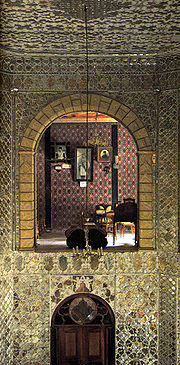
Maku, Iran
Encyclopedia

Iran
Iran , officially the Islamic Republic of Iran , is a country in Southern and Western Asia. The name "Iran" has been in use natively since the Sassanian era and came into use internationally in 1935, before which the country was known to the Western world as Persia...
. At the 2006 census, its population was 41,865, in 10,428 families.
It is situated 22 kilometres (13.7 mi) from the Turkish border in a mountain gorge at an altitude of 1634 metres. The Zangmar River
Zangmar River
The Zangmar River is a river in Maku Shahrestan, West Azarbaijan Province, Iran. It originates in the mountains above Maku, Iran along the Turkish-Iranian border, not far from Mount Ararat and flows south and east into the Araxes at the town of Pol Dasht....
cuts through the city. The common languages in Maku are Kurdish and Azerbaijani . Maku Free Trade and Industrial Zone
Foreign Direct Investment in Iran
Foreign direct investment in Iran has been hindered by unfavorable or complex operating requirements and by international sanctions, although in the early 2000s the Iranian government liberalized investment regulations. Iran ranks 62nd in the World Economic Forum's 2011 analysis of the global...
is Iran’s largest and the world’s second largest free trade zone and will encompass an area of 5000 square km when it will open in 2011.
History
Maku was the capital of a Kangarli Khanate one of numerous small, semi-independent KhanateKhanate
Khanate, or Chanat, is a Turco-Mongol-originated word used to describe a political entity ruled by a Khan. In modern Turkish, the word used is kağanlık, and in modern Azeri of the republic of Azerbaijan, xanlıq. In Mongolian the word khanlig is used, as in "Khereidiin Khanlig" meaning the Khanate...
s that resulted from the breakup of the Safavid empire in the 17th century.
The city is well-known in Bahá'í
Bahá'í Faith
The Bahá'í Faith is a monotheistic religion founded by Bahá'u'lláh in 19th-century Persia, emphasizing the spiritual unity of all humankind. There are an estimated five to six million Bahá'ís around the world in more than 200 countries and territories....
history for its fort where the Báb
Báb
Siyyid `Alí Muḥammad Shírází was the founder of Bábism, and one of three central figures of the Bahá'í Faith. He was a merchant from Shíráz, Persia, who at the age of twenty-four claimed to be the promised Qá'im . After his declaration he took the title of Báb meaning "Gate"...
had been exiled to and imprisoned for nine months. At this fortress Mullá Husayn
Mullá Husayn
Mullá Husayn-i Bushru'i , titled Jináb-i-Bábu'l-Báb , was a Persian religious figure, and the first Letter of the Living of the Bábí movement. He died at the Battle of Fort Shaykh Tabarsi, on February 2, 1849...
, the first Disciple of the Báb, arrived on Náw-Rúz of the year 1848 to see the Báb.
In ancient times the region of Maku was a part of Lesser Media
Medes
The MedesThe Medes...
and its name itself may be derived from the old Kurdish word Madkuh meaning "the Mountain of the Medes". Medes
Medes
The MedesThe Medes...
were the ancient Kurdish tribes.
Population
According to the 2006 census, the city has a population of 41,865 who speak mostly Kurdish and AzeriAttractions
- Baqcheh Jooq PalaceBaqcheh Jooq PalaceBaqcheh Jooq Palace is a palace located between the border towns of Maku and Bazargan in West Azarbaijan.It is situated in a vast garden covering about 11 hectares...
: dates back to the end of the Qajar period. It used to be the house of the local governor until 1974. It's 7 km northwest of central Maku and presently functions as a museum displaying some carpets and local handicrafts. - Ruins of a fortress are folded into a ledge of the high cliff that towers above the town centre.
- Hiking : it is advisable to have a guide or stay within eyesight of the town. Due to its proximity to the Turkish border, it is easy to cross the border unintentionally.
- Rock climbing: There are numerous rock climbing sites at the northern part of the city, some exceeding 200 meters.
- Panj Cheshmeh - This bridge is located 5 km. from Maku on the Zangmar River, and is a monument from the Safavid era. This bridge was constructed in order to facilitate communications between Tabriz and Maku, and the surrounding rural areas.
External links
- MakuCity.com
- Mahrāveh Soroushiān, Maku, a Passageway to Cultures (Maku, Gozar'gāh-e Farhang'hā), in Persian, Jadid Online, 9 February 2009, http://www.jadidonline.com/story/09022009/frnk/travel_to_maku.
An audio slideshow, http://www.jadidonline.com/images/stories/flash_multimedia/Travel_to_maku_test/maku_high.html (5 min 23 sec).

